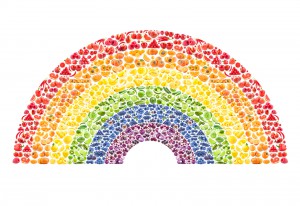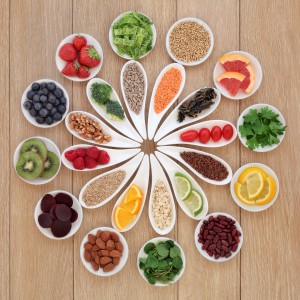People often ask me for hints and tips about what they ‘should’ eat, and how to follow a healthy diet. Everyone’s healthy is different, and I’m not a fan of the word ‘should’, but there are a few general principles that are likely to benefit most people most of the time.
There will be no rocket science in today’s post. My top tips for 2017 are based on the same thing as you aim for every year; eating a nutrient-rich diet and staying away from refined foods which are less nutritious. As I know you’d like me to get specific, here are my top-5 quick tips for general nutritional well-being.

Eat a rainbow to add variety and fun to your diet
1.Enjoy rainbows
Plant chemicals derived from vegetables and fruit appear to keep beneficial intestinal bacteria healthy and flourishing. Current thinking suggests that this not only benefits the digestive system, but helps take care of the liver, heart and brain as well (1). Since we don’t know enough about which combinations of chemicals are the most beneficial for each individual person, it makes sense to enjoy a wide variety. The best way to do this is to eat plenty of brightly coloured vegetables and fruit. Watch out for resources to help bring rainbows into your diet coming very soon (no green smoothies – promise!).

Beans, pulses, nuts, vegetables and fruit can all contribute to your fibre needs.
2. Rough it up
The benefits of eating fibre appear to go way beyond the old-fashioned idea that fibre ‘keeps you regular’. In fact, eating insoluble fibre (we used to call it ‘roughage’) may be harmful for some bowel problems (2). However, studies seem to agree that eating a sufficiently fibrous diet may protect against heart disease and cancer (3,4), and may even help to lower your blood pressure, and improve your response to sugars (5). The Government currently recommends that adults should aim to eat 30g fibre a day, although most of us only eat just over half of this (6).
Great sources of fibre include:
Oats
Chia seeds
Coconut
Almonds
Leeks
Onions
Artichokes
Baked Potatoes
Lentils
Split peas
Broad beans
Kidney beans
Chick peas

Water is your friend all year round.
3. Stay hydrated
Nobody quite knows why, but keeping hydrated is good for your health. My personal speculation (and it’s only a speculation) is that, since virtually every biological process in the human body needs water, and/or takes place in a fluid environment, these processes will operate better if the body is sufficiently hydrated.
It’s perhaps not surprising that drinking enough fluid appears to be protective against bladder cancer (7), but it also seems to help weight loss and blood sugar response (8, 9). Stick to water and teas where possible; fizzy drinks and even fruit juices contain high levels of sugar, and ‘diet’ drinks don’t seem to have the same benefits as water (8). However; take care. There’s no evidence to support the idea that everyone should drink 6-8 glasses a day, and overdrinking can be harmful, particularly if you drink too much too quickly. Sip your fluid throughout the day rather than drinking it all at once.
4. Keep it simple
Some nutritionists like to say that if something has more than 5 ingredients, it’s less likely to be healthy. Myself, I’m not so sure, because some of those ingredients could be wonderful, fragrant spices, which add flavour and interest to a dish, and are often said to have health benefits as well. I prefer the idea of the ‘grandmother diet’ (possibly ‘great-grandmother for the current generation), i.e. if your grandmother wouldn’t recognise it as food, it isn’t. The same applies to diets. If the latest trend is for complex weighing, measuring or restriction based on random factors such as your blood group, it’s probably bogus.
You don’t need to add a whole larder of food to ingredients to make it taste great. This year, resolve to enjoy fresh foods prepared simply; steamed, grilled, stir-fried, or even sometimes raw (but listen, I’m not a ‘raw foodie’!). It’s less fuss, and you’ll be surprised and delighted at how delicious the simple flavours of food can be.

Variety makes your diet both more interesting and more nutrient dense.
5. Variety is the spice of life.
Folks, I don’t think ‘superfoods’ really exist, so it’s time we stopped worrying about them. There was a time when I could barely mention that I hate kale. Now I feel happy to broadcast the fact, because Chinese leaf will provide me with just as much nutrition, and is a lot easier on my palate. If you love kale, broccoli or blueberries, fine. These are all great foods as part of a healthy diet, but there is no magic about them. If you happen not to enjoy them, simply find other nutrient-dense food that you do enjoy. Try out new things, because with greater variety can come greater nutrient density – and best of all, it’s fun!
I wish you a very happy, healthy 2017.
References
- Anderson, J.J.B., & Nieman, D.C., (2016). Diet quality – the Greeks had it right! Nutrients 8(1), 636 (published online).
- Brostoff, J., & Gamlin, L., (2008). The Complete Guide to Food Allergy and Intolerance. London, Quality Health Books.
- Threapleton, D.E., Greenwood, D.C. Evans, C.E., Cleghorn, C.L., Nykjaer, C., Woodhead, C., Cade, J.E., et al, (2013). Dietary fibre intake and risk of cardiovascular disease: systematic review and meta-analysis. British Medical Journal, 347, f6879.
- Kim, Y., & Je, Y., (2016). Dietary fibre intake and mortality from cardiovascular disease and all cancers: a meta-analysis of prospective cohort studies. Archives of Cardiovascular Disease, 109(1), 39-54.
- Chan, C.W., & Lee, P.H., (2016). Association between dietary fibre intake with cancer and all-cause mortality among 15740 adults: the National Health and Nutrition Examination Survey III. Journal of Human Nutrition and Dietetics, 29(5), 633-642.
- https://www.nutrition.org.uk/healthyliving/basics/fibre.html. [Accessed 20 January 2017].
- Zhou, J., Kelsey, K.T., Giovannucci, E., & Michaud, D.S., (2014). Fluid intake and risk of bladder cancer in the Nurses’ Health Study. International Journal of Cancer, 135(5), 1229-1237.
- Madji, A., Taylor, M.A., Delavari, A., Malekzadeh, R., Macdonald, I.A., & Farshchi, H.R., (2015). Effects on weight loss in adults of replacing diet beverages with water during a hypoenergetic diet: a randomized, 24-week clinical trial. American Journal of Clinical Nutrition, 102(6), 1305-1312.
- Stookey, J.D., Constant, F., Popkin, B.M., & Gardner, C.D., (2008). Drinking water is associated with weight loss in overweight dieting women independent of diet and activity. Obesity, 16(11), 2481-2488.





1 comment
Tolga Ersoy
January 21, 2018 at 11:31 pm (UTC 0) Link to this comment
Thanks for these important health tips.